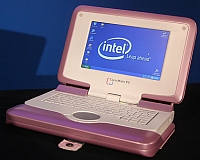From the very start, the One Laptop Per Child leadership has talked about collaboration, open and instant always-on connections between children as the very foundation of the OLPC $100 laptop CM1 2B1 XO Children's Machine.
But what about the times when the computers should not be mesh connected? Times when a teacher "closes a door"? Or as Xavier Alvarez explains on the OLPC Networking listserv:
The teacher usually closes the door (and probably windows) in order to isolate the class from outside interference... in a physical world, that's natural.Or IMing with the buddy in the next desk? From the beginning, I saw an always-on interclass mesh network as a wonderful endless IM session, with only the occasional giggle to betray massive virtual note passing.But on the digital world, how can the teacher ensure that the students are really not disturbed by outside sources? (ie: IMing with the buddy on the next classroom).
In addition, at test time, how can the teacher isolate students from each other and the outside world? How can a child's quiz answer be the work of one, and not of many? Even OLPC collaboration needs its limits.
As an answer to Xavier's question, Michael Burns responds with:
Because of the mesh network, inherently, there is no real way to 'turn off' collaboration. Indeed, I don't think you'd want to.So might that be what the Learning Vision wiki entry means when it says teachers will "focus their experience and expertise where most needed" - they will become over-glorified hall monitors?This is not a technical issue, however, it is really a social one. If students are disruptive, teachers will have to deal with them just as they do with passing notes and whispering. […]Teachers look over the shoulders of students as they take tests, etc.
Luckily, Xavier has a technology-based solution to help those teachers regain leadership in the classroom: sub-networks.
My idea was more like creating a sub-network of sorts. Assuming that the teacher also gets a laptop, it could be configured to work as an access-point/gateway/firewall and the kid's simply connect to it.Besides taking automatic attendance and other administrative tasks, the teacher's laptop could be set up to block all outside traffic, or create sub-subnets (MAC ids come to mind) so that collaborating workgroups could be created but only among themselves, while allowing even one-machine sub-nets (while in an exam).

The Classmate will also sport a special version of Windows that prevents kids from accessing Internet sites or adding programs that have been designated by parents or teachers as off-limits.Unfortunately for Xavier (and maybe teachers), Nicholas Negroponte's vision for the future of education in the developing world does not include such restrictions on collaboration. In the OLPC model, children are going to learn learning with open and instant always-on mesh networks guiding the way.The computer has software that can be used during classroom exercises. If a child tries to surf away from the lesson at hand, a message pops up saying, "Please pay attention to the professor."



So, when the children use the view-source feature http://www.olpcnews.com/hardware/keyboard/children_view_source.html and comment out http://xkcd.org/c156.html that annoying teacher-restricting code, is that successful learning, or cheating?